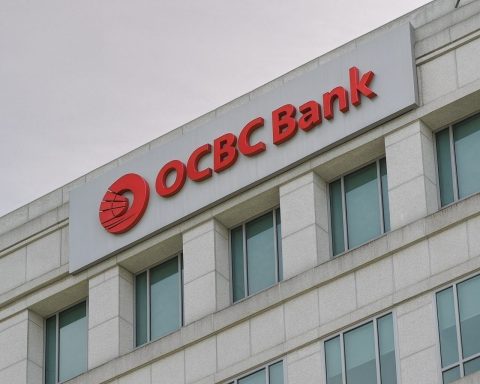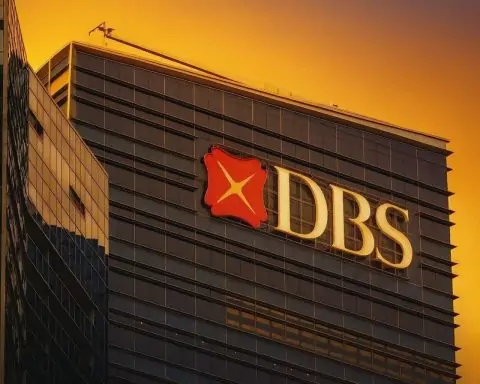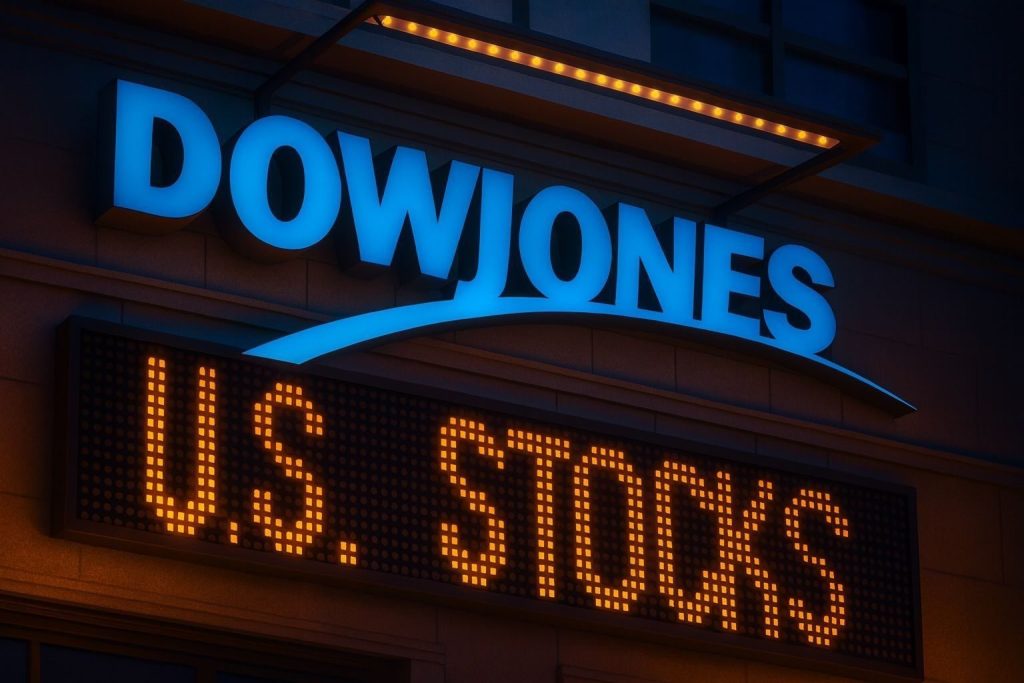Lloyds Banking Group shares were back in the spotlight on Tuesday, 25 November 2025, as investors cheered signs that the UK’s new government will spare banks from a fresh tax raid in Wednesday’s Budget. At the same time, analysts remain split on whether the stock is now cheap, fairly valued or running ahead of fundamentals.
Lloyds share price today: banks rally on Budget tax reprieve
Lloyds Banking Group’s London-listed shares (LSE: LLOY) closed around 90.2p, up roughly 3.2% on the day, after opening at 89.14p and trading as high as 91.44p. That puts the FTSE 100 lender within sight of its recent 52‑week high of 95.7p, with a market value just over £53bn and a current price/earnings ratio near 13.9x. The indicated dividend yield at today’s close is about 3.5%. [1]
The move came as UK stocks edged higher overall. The FTSE 100 added about 0.2%, while the FTSE 250 gained 0.1%, but banks stood out after a Goldman Sachs note picked up on a Financial Times report suggesting the sector will be spared new taxes in Chancellor Rachel Reeves’s first Budget. Lloyds rose around 1.8% in early trade alongside gains in Barclays and NatWest. [2]
According to a Sharecast report hosted by Halifax, UK bank shares “rallied” after the FT said the Treasury had asked lenders to provide prominent endorsements of the Budget and show how new policies will support lending to first‑time buyers and small businesses. NatWest was up about 3.2%, while Lloyds and Barclays each gained roughly 2.5–2.6% by mid‑morning. [3]
Similar moves were reported across multiple outlets. PA/Press Association coverage carried by The Independent and The Irish News noted that Lloyds, Barclays and NatWest were among the biggest FTSE 100 risers, with share prices up about 2% on expectations that a planned rise in the bank levy would be dropped. [4]
US-based site Somos Hermanos, summarising the same FT story, reported that NatWest climbed over 3%, Lloyds nearly 3% and Barclays around 2.9%, as investors digested talk of a Budget “tax reprieve” for lenders. [5]
From stock market dip to relief rally: what changed in a week?
The sharp bounce in Lloyds comes after a burst of volatility in November.
Analysts at Simply Wall St highlight that the stock has climbed 66% over the past year and almost 190% over five years, yet still dropped about 7.9% in a single week earlier this month after a rapid 5.6% surge in October. [6]
That choppiness triggered a wave of commentary:
- On 19 November, The Motley Fool UK ran a piece asking whether the latest stock market dip was an “unmissable opportunity” to buy Lloyds shares, arguing that anxious markets had knocked down even solid blue‑chip names. [7]
- Around the same time, a Yahoo Finance article titled “Lloyds (LSE: LLOY): Exploring Valuation After Strong Year‑to‑Date Share Price Gains” examined whether the rally had already priced in much of the good news. [8]
Price data from Yahoo Finance shows Lloyds closing between roughly 88–89p on 19–21 November, dipping to about 86p on 21 November before edging back to just under 88p on 24 November. [9] Today’s push above 90p therefore marks a clear relief rally rather than the start of a brand‑new trend.
How cheap or expensive is Lloyds now? Conflicting valuation signals
Today’s price still leaves Lloyds comfortably below its 52‑week high, but investors looking under the bonnet are finding mixed messages on valuation.
Fundamental models: attractive on intrinsic value…
Simply Wall St’s in‑depth valuation work uses an “Excess Returns Model” that looks at how much profit Lloyds is expected to generate above its cost of equity. Based on analyst estimates of:
- Book value per share of about £0.77,
- Stable EPS around £0.10, and
- an average return on equity near 13.1%,
their model puts intrinsic value at about £1.44 per share – roughly 39% above the market price at the time of their analysis. On that measure, they classify Lloyds as undervalued. [10]
…but pricey on earnings multiples
The same analysis notes that Lloyds currently trades on a P/E ratio of about 14.9x, versus an average of 10.6x for UK banking peers and roughly 10x for the broader sector. Simply Wall St’s own “fair” multiple for Lloyds, taking account of growth and risk, is around 9.7x – implying the shares could be overvalued when viewed purely through a P/E lens. [11]
Broker data from Hargreaves Lansdown adds further colour. At today’s close:
- P/E: 13.87x
- Historic dividend yield: about 5.8% for the 2024 financial year, when Lloyds paid total ordinary dividends of 3.17p per share.
- 1‑year price performance: +60.6%
- 5‑year performance: +121%. [12]
Put simply, Lloyds still offers a higher yield than many FTSE 100 names, but its rating is no longer “dirt cheap” relative to domestic peers. Whether you see it as a bargain or fully priced now depends heavily on your assumptions about future earnings, interest rates and regulation.
Fundamentals: motor finance scandal, Q3 results and buybacks
Any view on Lloyds today has to grapple with the motor finance mis‑selling scandal and the hit it has already delivered to earnings.
Reuters reports that in October the bank’s third‑quarter profit fell by 36%, and management downgraded full‑year guidance after booking an £800m charge linked to the UK regulator’s proposed compensation scheme. [13]
Even after that blow, the group’s Q3 2025 interim management statement shows:
- A banking net interest margin of 3.04% for the first nine months of 2025, up from 2.94% a year earlier as higher rates continued to support lending margins. [14]
- Return on tangible equity of 11.9% over the same period, down from 14% but still comfortably above the group’s long‑term cost of equity. [15]
Lloyds’ base‑case economic scenario points to:
- Slow but positive GDP growth,
- A gradual rise in unemployment to around 5%,
- Modest house price gains, and
- UK Bank Rate falling towards 3.5% in 2026 as inflation trends back to target. [16]
That backdrop suggests limited scope for further margin expansion and an eventual squeeze as rates fall, even if credit losses remain manageable.
£1.7bn share buyback continues
Despite the regulatory overhang, Lloyds is pressing ahead with a £1.7bn share buyback. A news summary based on recent regulatory filings notes that:
- By the end of September, the bank had already repurchased around 1.8bn shares for £1.4bn.
- On 20–21 November it bought a further 10,840,399 ordinary shares at an average price of 87.55p, with all shares to be cancelled, reducing the overall share count and boosting per‑share metrics. [17]
Today’s Hargreaves Lansdown data confirms that capital returns have been a key plank of the equity story, with recent interim and final dividends of 1.22p and 2.11p respectively for 2025 so far. [18]
In other words, Lloyds is still returning substantial cash to shareholders even as it absorbs regulatory charges – something shareholders will welcome, but which may raise political eyebrows.
Budget reprieve: what the latest policy signals mean for Lloyds
The centrepiece of today’s market move is politics, not just profits.
Multiple outlets report that Reeves’s Treasury had been weighing new taxes on banks, including a higher bank levy and potential levies on interest earned on reserves created through quantitative easing. Think‑tank IPPR said in August that such measures could raise up to £8bn a year for public services. [19]
But PA’s business coverage (via The Independent and The Irish News) now says the Chancellor is preparing to avoid hitting lenders with higher taxes, and will instead ask them to demonstrate how they will increase lending to first‑time buyers and small businesses, in line with the government’s growth agenda. [20]
Commentators at Shore Capital describe this as a “quid pro quo”: in exchange for escaping extra taxes, big banks may be expected to cut pricing and loosen the purse strings a little, stimulating credit demand instead of “harvesting the benefits of higher interest rates” purely through dividends and buybacks. [21]
The Guardian’s banking coverage points out that UK banks have lobbied heavily against further tax hikes, arguing that their effective tax rate is already near 46%, compared with about 39% in Frankfurt and 28% in New York. It also warns that U‑turns are “a theme in UK politics”, meaning bank boards may not fully relax until the Chancellor has finished her speech on Budget day. [22]
For Lloyds, as the UK’s largest retail and SME lender, that mix of relief and conditionality is crucial:
- No new levy now removes a major short‑term threat to earnings.
- But pressure to lend more and price more keenly could temper margin expansion and limit the scope for ever‑rising shareholder payouts.
Digital strategy: AI assistant, Curve and “Outstanding” digital bank status
While tax headlines dominate today, Lloyds has also been busy remaking itself as a digital and AI‑driven bank, which is increasingly central to the long‑term investment case.
AI‑powered financial assistant for 21m customers
Earlier this month, Lloyds unveiled plans for what it describes as the UK’s first large‑scale, multi‑feature AI‑powered financial assistant inside its mobile app, aimed at more than 21 million customers. [23]
According to the bank’s press release and coverage in Fintechnews Switzerland:
- The assistant will use generative and “agentic” AI to provide round‑the‑clock personalised guidance, from spending insights to savings and investment tools. [24]
- Customers will be able to have natural‑language conversations about their finances, with the system escalating to human staff when needed. [25]
- From 2026, features will expand to cover mortgages, car finance and protection products, potentially deepening cross‑selling and customer engagement. [26]
Lloyds says the assistant is built on its own “AI assurance framework and guardrails” to ensure safe and explainable interactions – an important point as regulators look closely at AI in financial services. [27]
Curve acquisition and digital recognition
On the payments side, Lloyds has agreed a reported £120m deal to acquire Curve, a fintech that consolidates multiple cards into a single digital wallet – although one major Curve shareholder has launched a legal challenge in an attempt to block the sale. [28]
Meanwhile, the group has been recognised as “Outstanding” in Euromoney’s 2025 Global Digital Banking Report, underscoring its positioning as one of the leading digital and AI‑enabled banks globally. [29]
Taken together, the AI assistant, Curve deal and Euromoney recognition suggest that Lloyds is trying to justify a higher valuation multiple by behaving more like a tech‑savvy, fee‑generating digital platform – not just a traditional UK mortgage and current‑account bank.
Bull vs bear case for Lloyds after today’s jump
The bull case: still room to run?
Supporters of the stock point to several positives:
- Tax reprieve (for now): The Budget is now expected to avoid new sector‑specific levies, reducing one of the biggest near‑term threats to UK bank earnings. [30]
- Solid profitability: Even after the motor finance charge, Lloyds is generating a double‑digit return on tangible equity and a healthy net interest margin above 3%. [31]
- Capital returns: The bank is on track to complete a £1.7bn buyback this year, alongside regular dividends, effectively shrinking the share count while paying investors a cash yield. [32]
- Digital edge: AI initiatives and the Curve acquisition show a clear push towards higher‑value digital services, validated by Euromoney’s “Outstanding” rating. [33]
- Potential undervaluation: Some intrinsic‑value models suggest the shares trade at a material discount – around 39% – to fair value, offering upside if earnings track expectations. [34]
The bear case: policy, rates and scandal risk
Sceptics see reasons for caution:
- Regulatory overhang: The FCA’s motor finance redress scheme remains a live issue, and Lloyds has already taken an £800m charge with the potential for further costs depending on final rules and complaint volumes. [35]
- Policy uncertainty: Today’s relief could prove temporary. Campaign groups continue to push for windfall taxes on bank profits, and commentators note that political U‑turns have been frequent in recent years. [36]
- Margin pressure ahead: Lloyds’ own economic scenarios imply gradually lower interest rates in coming years, which would squeeze net interest margins unless lending volumes or fee income accelerate. [37]
- Valuation vs peers: With a mid‑teens P/E multiple and a premium to UK banking peers, some investors worry that good news is now largely in the price, especially after a 60%+ 12‑month run. [38]
What to watch next
For investors and savers tracking Lloyds in the days ahead, key catalysts include:
- Rachel Reeves’s Budget (26 November 2025)
Markets will look for confirmation that banks are indeed spared further tax hikes – and for any strings attached in terms of mandated lending or pricing commitments. [39] - Updates on the motor finance redress scheme
The ultimate cost of compensation remains highly uncertain and could materially affect capital buffers and future buybacks. [40] - Progress on AI and digital initiatives
Investors will want to see the AI financial assistant roll out successfully and the Curve acquisition integrated smoothly, with evidence that these projects boost customer engagement and fee income rather than just adding cost. [41] - 2025 full‑year results (scheduled for 29 January 2026)
Lloyds’ own calendar points to end‑January for preliminary results, when management will update guidance, capital return plans and the outlook for UK credit conditions. [42]
Disclaimer: This article is for information and news reporting only and does not constitute personal financial advice. Anyone considering investing in Lloyds Banking Group or any other security should do their own research and, if necessary, consult a qualified adviser.
References
1. www.hl.co.uk, 2. www.reuters.com, 3. www.investments.halifax.co.uk, 4. www.the-independent.com, 5. somoshermanos.mx, 6. simplywall.st, 7. www.fool.co.uk, 8. finance.yahoo.com, 9. finance.yahoo.com, 10. simplywall.st, 11. simplywall.st, 12. www.hl.co.uk, 13. www.reuters.com, 14. www.lloydsbankinggroup.com, 15. www.lloydsbankinggroup.com, 16. www.lloydsbankinggroup.com, 17. somoshermanos.mx, 18. www.hl.co.uk, 19. www.the-independent.com, 20. www.the-independent.com, 21. www.irishnews.com, 22. www.theguardian.com, 23. www.lloydsbankinggroup.com, 24. fintechnews.ch, 25. fintechnews.ch, 26. fintechnews.ch, 27. fintechnews.ch, 28. www.lse.co.uk, 29. www.lloydsbankinggroup.com, 30. www.investments.halifax.co.uk, 31. www.lloydsbankinggroup.com, 32. somoshermanos.mx, 33. www.lloydsbankinggroup.com, 34. simplywall.st, 35. www.reuters.com, 36. www.theguardian.com, 37. www.lloydsbankinggroup.com, 38. simplywall.st, 39. www.investments.halifax.co.uk, 40. www.reuters.com, 41. fintechnews.ch, 42. www.lloydsbankinggroup.com







